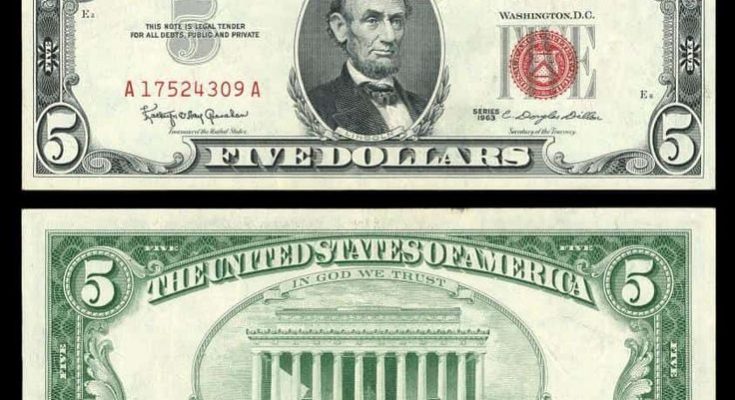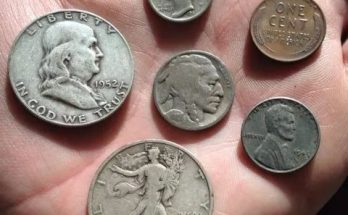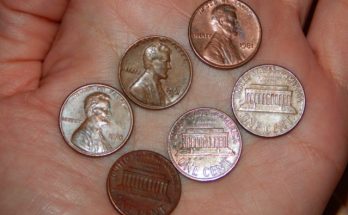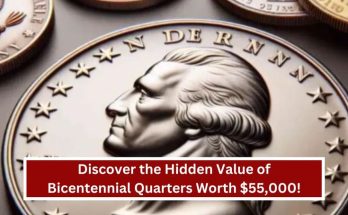Table of Contents
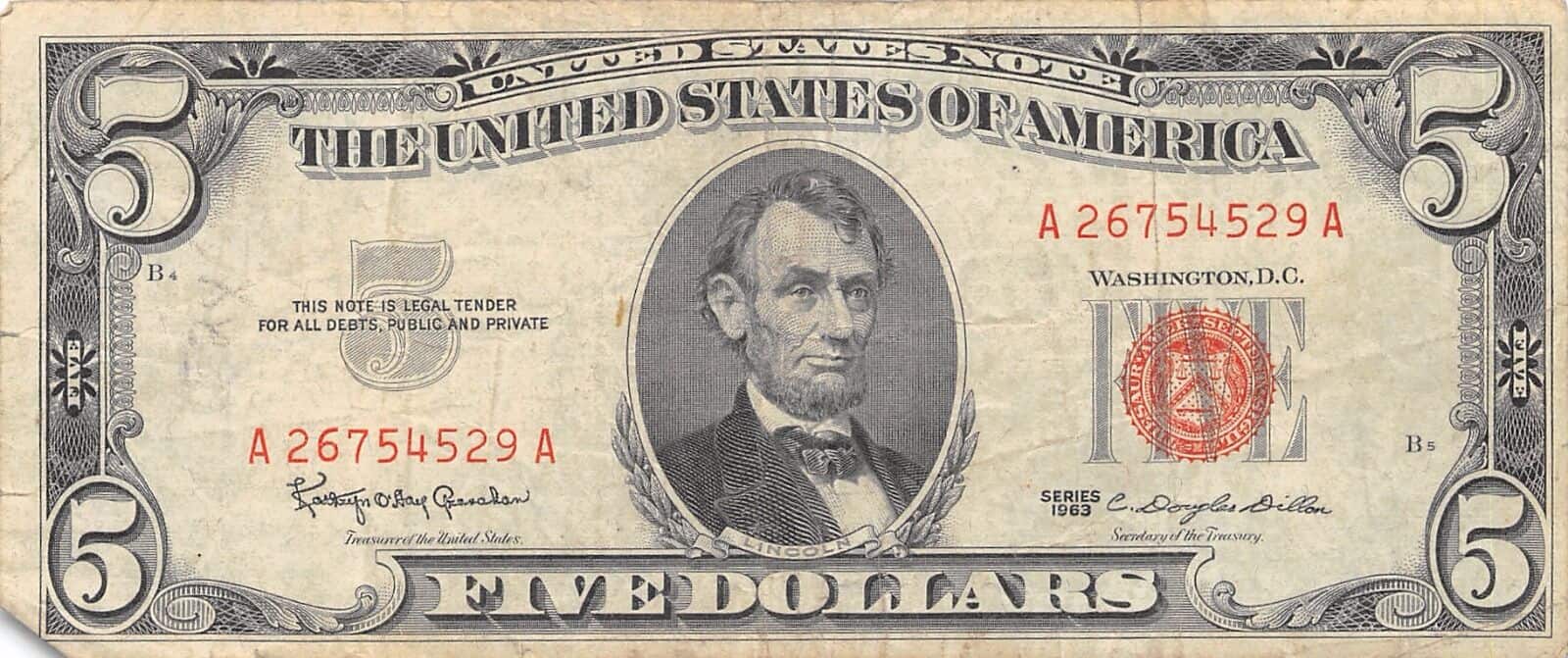
But what if I told you that even if they all look the same, they’re all of the different values? This is the case for some of the 1963 $5 dollar bills. There were three variations of the five-dollar bill printed out that year, and some of them are more valuable today than others.
Today, we’re going to dig deep into how much the 1963 $5 dollar bill value is today, what it means to have either a red or green seal, and the factors that can potentially make these 60-year-old bills worth more than meets the eye.
1963 $5 Dollar Bill Value Details
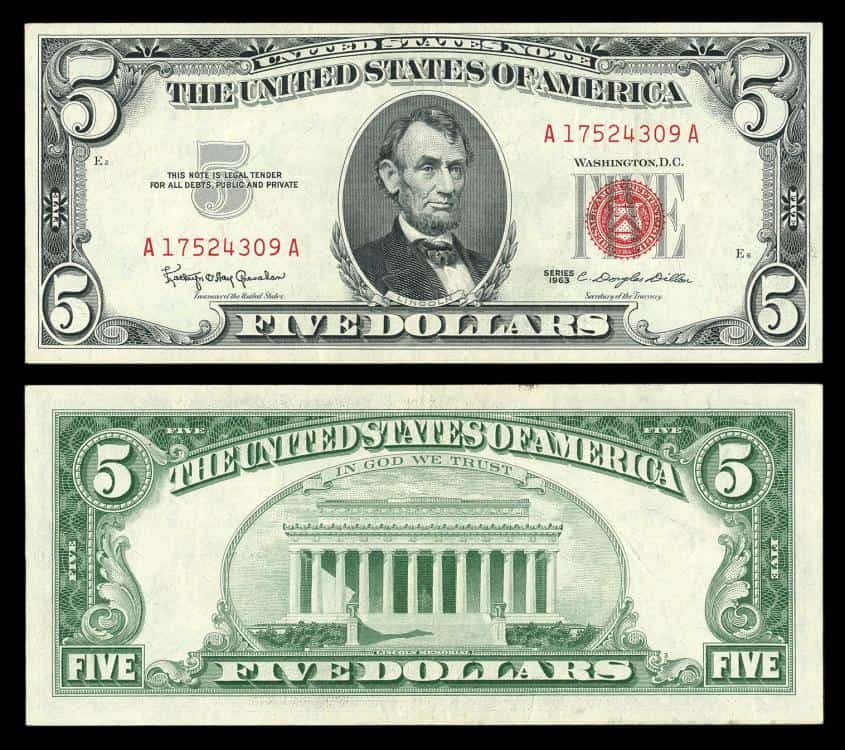
- Category: Five-Dollar Bills
- Printed by: Bureau of Engraving and Printing
- Printing location: Washington, D.C.
- Total bills made: 63 million notes
- Bill height: 66.3 mm
- Bill width: 156 mm
- Material used: 75% cotton and 25% linen
- Weight: 0.035 oz or 1 gram
There are three types of 1963 $5 dollar bills—one with a red seal, and two with a green seal. All of these were printed by the Bureau of Engraving and Printing and started circulating to the general public in the same year.
The obverse of the bill depicts the portrait of Abraham Lincoln, the 16th president of the United States of America. You’ll see the treasury seal—either red or green—on the right side of the bill. You’ll also find “5” on each corner of the bill, as well as “Five Dollars” written at the bottom.
On the lower-left and upper-right hands of the bill, you’ll see a unique serial number. The numbers should be identical on both sides. The bottom area of the bill is where you’ll find the signatures of the Treasurer and Treasury Secretary.
Before 1963, the obverse used to have the words “Will pay to the bearer on demand,” but it was removed for the first time that year.
Meanwhile, the reverse shows the Lincoln Memorial with the motto “In God We Trust” written above it. 1963 was the first year this phrase was added to the five-dollar banknote.
1963 $5 Dollar Bill Value Chart
| 1963 $5 Dollar Bill Value Chart | ||||
| Mint Mark | Circulated (Good) | Circulated (Very Fine) | Uncirculated | Notes with Stars |
| 1963 $5 Dollar Bill Value (Red Seal) | $6 | $13.50 | $15 to $25 (MS63) | $25 to $90 |
| 1963 $5 Dollar Bill Value (Green Seal) | $5 | – | $10 to $20 | $25 to $40 |
| 1963 A $5 Dollar Bill Value (Green Seal) | $5 | – | $10 to $20 | $25 to $40 |
1963 $5 Dollar Bill Values and Varieties Guides
1963 $5 Dollar Bill Value (Red Seal)

- Type: Legal Tender Note
- Seal: Red
- Treasurer: Granahan
- Secretary: Dillon
- Year of printing: 1963
- Face value: $5
- $ price: $6 to $90
The 1963 $5 dollar bill with a red seal is the most valuable of the three types printed by the Bureau of Engraving and Printing that year.
A red seal appears on money that was issued by the US government from 1862 to 1971. The seal meant that the Treasury had a direct obligation to redeem that note to get silver or gold. In short, money with a red seal was part of the country’s national debt.
Today, these legal tender notes are no longer redeemable by the US government. They were removed from circulation in the 1960s. The five-dollar bill is famously the last banknote series that had a red seal. The 1963 series is the last of those five-dollar bill runs, making it more special.
Because red seal 1963 five-dollar bills aren’t in circulation anymore, they’re more valuable as collectibles than their counterparts with green seals.
In good condition, you could sell a 1963 $5 dollar bill with a red seal for $6, a dollar more than its face value. And if you find one in MS63 uncirculated condition, you could score up to $25 for it.
Another factor that could raise prices for a 1963 $5 dollar bill with a red seal is a star on the serial number. Star notes are created to replace a banknote that the Bureau of Engraving and Printing has deemed defective.
You can tell if a bill is a star note if there is a star right before its serial number. These notes are rare and can boost the price of any 1963 $5 dollar bill. For one with a red seal, you could sell it for $25 to $90.
1963 $5 Dollar Bill Value (Green Seal)
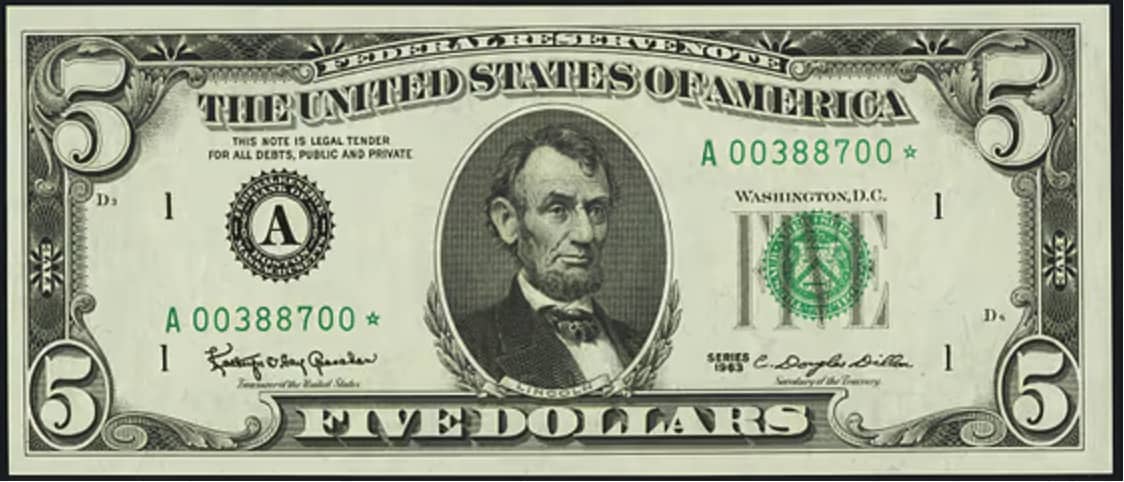
- Type: Federal Reserve Note
- Seal: Green
- Treasurer: Granahan
- Secretary: Dillon
- Year of printing: 1963
- Face value: $5
- $ price: $5 to $40
Let’s move on to the Federal Reserve Notes, also known as the banknotes used by US citizens today. The 1963 $5 dollar bill with a green seal is one such note. Because they are currently being issued by banks and are immensely abundant in circulation, their value isn’t that high.
A 1963 $5 dollar bill with a green seal only costs the same as its face value of $5. But if you find one in uncirculated condition without many imperfections and folds, you could sell it for anywhere between $10 to $20, which isn’t bad considering it’s still a bill in circulation today.
Stars in the serial number also raise the price for the 1963 $5 dollar bill with a green seal. Star notes are valued at $25 to $40.
Ten out of the twelve federal reserve banks issued this bill back in 1963. The Richmond and Minneapolis banks didn’t issue these bills, so there’s still a slight bit of rarity compared to the 1963A five-dollar bill, which we’ll talk about in a bit.
1963A $5 Dollar Bill Value (Green Seal)
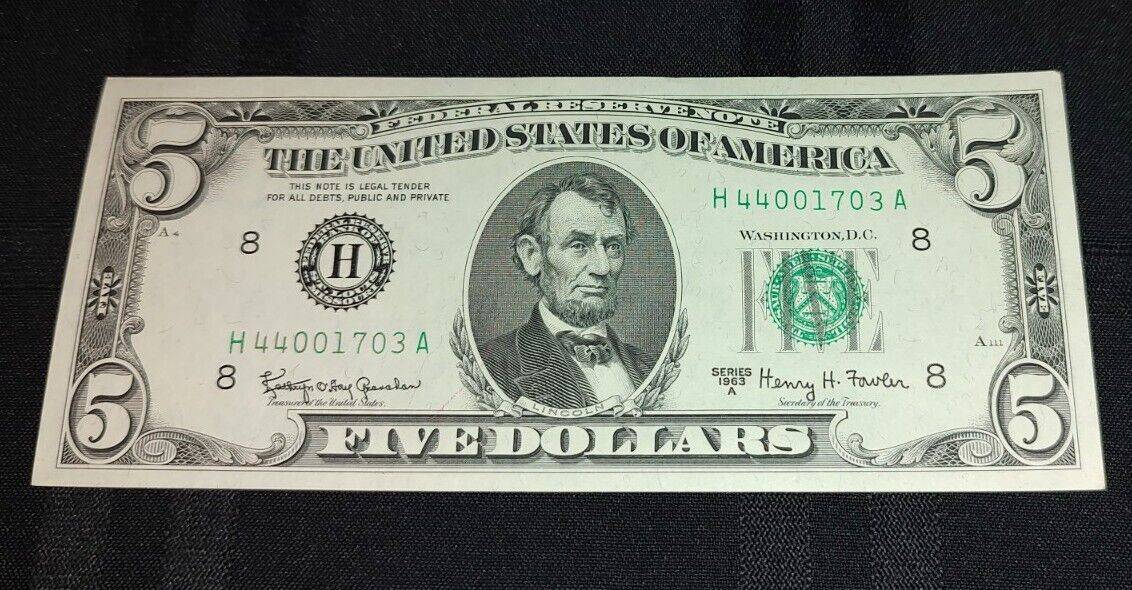
- Type: Federal Reserve Note
- Seal: Green
- Treasurer: Granahan
- Secretary: Fowler
- Year of printing: 1963
- Face value: $5
- $ price: $5 to $40
The 1963A five-dollar bill will seem almost identical to the previous note if you don’t look closely. They have the same obverse and reverse and denomination—they even have the same green seal.
So, it should come as no surprise that the value of these two five-dollar bills from 1963 are the same as well.
In good condition, a 1963A five-dollar note will cost $5, which is equal to its face value. This price goes up for uncirculated and star note bills, getting you up to $20 and $40, respectively.
However, there are two main differences between the 1963 and 1963A series of five-dollar bills.
The first is that instead of being signed by Secretary Dillon, the 1963A bills were signed by Secretary Fowler.
The second and more significant difference is that all 12 federal reserve banks participated in printing out the 1963A five-dollar bill. This implies that it’s less rare than the 1963 bill printed by only 10 banks.
Because of this, 1963A bills are often more affordable than the 1963 version of the five-dollar bill, but only by a little bit.
History of the 1963 $5 Dollar Bill
In 1863, President Lincoln signed the National Currency Act, which paved the way for a uniform national currency—the US dollar. This made it possible to print out banknotes for public circulation.
But what’s funny is that Abe Lincoln wasn’t on the first-ever five-dollar bill. No, it was actually Alexander Hamilton, the country’s first Secretary of the Treasury, who was featured on the note alongside the Statue of Freedom.
It wasn’t until 1914 that Lincoln first appeared on the $5 bill. It was a way for the country to honor this great president’s achievements in the Civil War, the abolishment of slavery, and for modernizing the US economy.
And after that first run, he continued to stay on the five-dollar banknote, which leads us to the five-dollar bill as we know it. 1963 saw three types of five-dollar bills: one legal note tender that the government traded in for gold or silver, and two federal reserve notes.
Although the design of the bill would change every few decades, one thing stayed the same—it always honored the great Abe Lincoln.
1963 $5 Dollar Bill Grading
More than the face value and seal type of a 1963 $5 dollar bill, it’s really the quality grading that will determine what its value is today. The better the quality and condition it’s in, the higher the value of your bill.
Here are a few ways the PCGS might grade a 1963 $5 dollar banknote according to wear and paper quality:
- Fair (2): Most of the paper is still intact, but with larger chunks torn or missing. You can tell it’s been overused and it has lost most of its crispness.
- Very Good (10): Light wear and has multiple folds, but still bright in design and color.
- About Uncirculated (53): Great eye appeal and crispness, but with two vertical folds.
- Gem Uncirculated (65 PPQ): Very light handling with no folds; you can tell it hasn’t been used. Little to no misalignment with printing, and the design is still clear and intact.
Watch this video for more tips on how to grade your paper bills:
1963 $5 Dollar Bill Errors
1. 1963 $5 Dollar Bill Dual Denomination Error
A common printing error among five-dollar bills is the dual denomination error. That means that it could be a $5 design in the front, but when you flip it over, you’ll see another denomination on the reverse, like say, a $10 bill.
One known instance of this error was on a five-dollar bill printed in 1934. In 2020, this bill was auctioned off for $25,000! It’s possible to find something like this in a 1963 $5 dollar bill, so watch out.
2. 1963 $5 Dollar Bill Mismatched Serial Number Error
Another common error in any banknote is serial numbers that don’t match. On the upper-right and lower left-hand corner of each five-dollar bill, you should see the same exact serial numbers. But sometimes, a mechanical error occurs and the numbers don’t match.
A note like this can be sold for thousands of dollars.
3. 1963 $5 Dollar Bill Ink Smear Error
One of the more dramatic errors when printing out dollar bills is the ink smear error. When this happens, the ink used to print the design on the obverse or reverse becomes smudged or smeared. This happens when the ink jets at the Bureau of Engraving & Printing get jammed or malfunction.
One way you can tell that a five-dollar bill with an ink smear is legitimate is if it has a red rejection mark on its left side.
Check out what other common five-dollar bill errors look like by watching this video by Old Money Prices:
1963 $5 Dollar Bill Value FAQs
How much is a $5 bill worth with a red seal?
There are three five-dollar bill series that were printed with a red seal, namely 1928, 1953, and 1963 series. Across all three series, the value of a five-dollar bill with a red seal isn’t much different from its face value, especially if it’s a circulated bill that is in average, good, or fine condition.
But if the $5 bills with red seals were uncirculated and were in pristine condition, the value today would be much higher. It could go from $40 to $50 dollars if the banknotes were in tip-top shape.
How much is an old $5 dollar bill worth?
To be honest, a five-dollar bill won’t be worth that much money today. It might cost the same as it did when it was printed at $5.
But if you’re lucky enough to have found an old five-dollar bill that was either uncirculated or has rare errors in its printing, then you might be able to sell it for much higher, around $50.
How can you tell if a 5 dollar bill is worth money?
You can tell that a $5 bill is worth more money than people expect if it’s uncirculated and printed many years ago, like the 1963 notes. Uncirculated bills are usually in prime condition without many folds and creases, so it’s worth collecting.
A five-dollar bill might also be worth a lot if it has errors that make it rare and hard to find.
